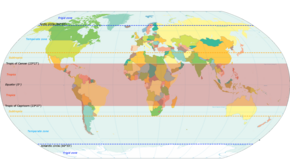

The subtropical zones or subtropics are geographical and climate zones to the north and south of the tropics. Geographically part of the temperate zones of both hemispheres, they cover the middle latitudes from 23°26′09.8″ (or 23.43605°) to approximately 35° north and south. The horse latitudes lie within this range.
Subtropical climates are often characterized by hot summers and mild winters with infrequent frost. Most subtropical climates fall into two basic types: humid subtropical (Köppen climate classification: Cfa/Cwa), where rainfall is often concentrated in the warmest months, for example Southeast China and the Southeastern United States, and dry summer or Mediterranean climate (Köppen climate classification: Csa/Csb), where seasonal rainfall is concentrated in the cooler months, such as the Mediterranean Basin or Southern California.
Subtropical climates can also occur at high elevations within the tropics, such as in the southern end of the Mexican Plateau and in Da Lat of the Vietnamese Central Highlands. The six climate classifications use the term to help define the various temperature and precipitation regimes for planet Earth.
A great portion of the world's deserts are within the subtropics, as this is where the semi-permanent subtropical anticyclone resides (typically inland on the southwest sides of continents). Areas bordering warm oceans (typically on the southeast sides of continents) have hot and wet summers with frequent (but brief) convective rainfall (tropical cyclones can also contribute to annual rainfall). Areas bordering cool oceans (typically on the southwest sides of continents) are prone to fog, aridity, and dry summers. Plants such as palms, citrus, mango, pistachio, lychee, and avocado are grown in the subtropics.